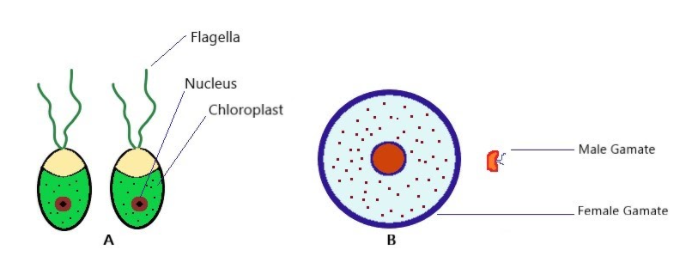
Given figures labelled by A and B represent
A B (1) Isogametes of Rhizopus Heterogametes of Fucus (2) Isogametes of Cladophora Heterogametes of Pinus (3) Isogametes of Rhizopus Heterogametes of angiosperms (4) Isogametes of Chara Heterogametes of Synchytrium

| A | B | |
| (1) | Isogametes of Rhizopus | Heterogametes of Fucus |
| (2) | Isogametes of Cladophora | Heterogametes of Pinus |
| (3) | Isogametes of Rhizopus | Heterogametes of angiosperms |
| (4) | Isogametes of Chara | Heterogametes of Synchytrium |

Answer
563.7k+ views
Hint: Iso means similar. Therefore isogametes means gametes that are similar in size and form to the one that unites during the time of fertilization. No difference is seen in terms of size, sex or structure. Heterogametes do differ in size and form. Hence, they are morphologically dissimilar and so the male and female gametes can be distinguished.
Complete answer:
As the hint suggests, the isogametes are the same in appearance. So, the picture on the left is a depiction of isogamy whereas the picture on right is heterogametic.
1) Isogametes of Rhizopus and Heterogametes of Fucus- Rhizopus is a saprophytic fungus which can grow as filamentous branching hyphae. In oomycetes of Fucus, large non-motile female fuses with motile male gametes. This option is the most suitable one in terms of appearance and the definition as well.
2) Cladophora is reticulated filamentous green algae. In this, the sexual reproduction is isogamous. Pinus looks like a cone and they are the largest genus of conifers.
3) Angiosperms make up the majority of all plants on Earth. They are vascular plants. Their seeds can be found in a flower.
4) Chara is a freshwater green algae which can be found in submerged shallow water. Synchytrium is simple parasitic fungi. It is unicellular in nature.
Therefore option 1 is the most appropriate and correct option.
Note: Rhizopus are cosmopolitan in nature which can be commonly found in soil, decaying fruit and vegetables. Rhizopus has many different species. There are some morphological characteristics like the sporangia diameter, length of rhizoids, shape, size and texture which helps to differentiate each of its species.
Complete answer:
As the hint suggests, the isogametes are the same in appearance. So, the picture on the left is a depiction of isogamy whereas the picture on right is heterogametic.
1) Isogametes of Rhizopus and Heterogametes of Fucus- Rhizopus is a saprophytic fungus which can grow as filamentous branching hyphae. In oomycetes of Fucus, large non-motile female fuses with motile male gametes. This option is the most suitable one in terms of appearance and the definition as well.
2) Cladophora is reticulated filamentous green algae. In this, the sexual reproduction is isogamous. Pinus looks like a cone and they are the largest genus of conifers.
3) Angiosperms make up the majority of all plants on Earth. They are vascular plants. Their seeds can be found in a flower.
4) Chara is a freshwater green algae which can be found in submerged shallow water. Synchytrium is simple parasitic fungi. It is unicellular in nature.
Therefore option 1 is the most appropriate and correct option.
Note: Rhizopus are cosmopolitan in nature which can be commonly found in soil, decaying fruit and vegetables. Rhizopus has many different species. There are some morphological characteristics like the sporangia diameter, length of rhizoids, shape, size and texture which helps to differentiate each of its species.
Recently Updated Pages
Why are manures considered better than fertilizers class 11 biology CBSE

Find the coordinates of the midpoint of the line segment class 11 maths CBSE

Distinguish between static friction limiting friction class 11 physics CBSE

The Chairman of the constituent Assembly was A Jawaharlal class 11 social science CBSE

The first National Commission on Labour NCL submitted class 11 social science CBSE

Number of all subshell of n + l 7 is A 4 B 5 C 6 D class 11 chemistry CBSE

Trending doubts
Differentiate between an exothermic and an endothermic class 11 chemistry CBSE

10 examples of friction in our daily life

One Metric ton is equal to kg A 10000 B 1000 C 100 class 11 physics CBSE

Difference Between Prokaryotic Cells and Eukaryotic Cells

State the laws of reflection of light

Explain zero factorial class 11 maths CBSE




